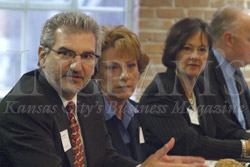
Steve Block of Block and Company discusses development trends in Kansas City’s urban core. Lori Harp and Debora Field look on.
For Kevin Nunnink, the real issue is “net rent growth.” In this regard, “there’s been no net rent growth in this city for 20 years.” He fears that with interest rates being a function of capitalization, once interest rates start to rise, the effect on building value will be problematic.
“I think, Kevin, you touched on it right there,” Tom Turner said. “The value of real estate may take a significant hit over what people think it is.” As interest rates inch up, and the spread over treasuries starts to widen, Turner believes that real estate may become relatively less attractive as an investment vehicle.
Industrial
“We had a pretty good year last year,” Monsees said. Although sale prices are fairly strong, with reasonably good absorption, the momentum into 2005 “isn’t as strong as I’d like for it to be.” Still, he believes the industrial market has a much better chance of staying healthy and recovering than the office market does.
“I would concur with Olen,” said Ed Elder. The momentum is not as strong as he would like to see, but close to three million-plus square feet have been absorbed in the last few years, and that has been encouraging. Although the cost of construction has grown, Elder expects to see some limited speculative construction in Johnson County, enough to keep the rates “very competitive.”
Retail
Dan Lowe reported that the retail sector, which has performed well even in difficult years, remains “extremely strong.” Although some areas are “a little overbuilt,” particularly in South Johnson County, he believes there are still some real growth opportunities available.
“I think we’re going to continue to see retail growth,” added LaSala, “because we’re continuing to see residential growth.” The fact that the residential growth is expanding in all directions—given the city’s lack of natural barriers—allows for a more balanced spread of retail. As Larry Buck noted, retail in turn provides more jobs, which demand more growth. Still, he noted, “There has to be some point in time where retail has to slow down a little bit.”
The one area of retail that has not grown, neither here nor anywhere, is the enclosed mall. As LaSala noted, a few malls in the market are doing well, but others may have to be redeveloped “into something other than what they are. I think part of what happened to the malls is a change in our lifestyle.”
Opportunities
Lori Harp of CEAH Realtors took the opportunity when asked to cite challenges to cite what is really an opportunity. She noted “all the really exciting things that are happening,” particularly in eastern Jackson County, and posed as a challenge—the difficulty of bringing all relevant people to the table and deciding on one vision as to how the community moves forward.
Buck also turned his challenge question into an opportunity, namely how to educate more users to the opportunities they would have were they to relocate to our markets. Field agreed. “When you do a location analysis,” she noted, “and compare yourself with other cities, we are very moderately priced in all areas.”
“I’m a real believer in the quality of life issues,” Bates affirmed. “The affordability issues are KC’s base.”
Murray took heart in the shift in governmental attitudes. “We have seen tremendous changes because of strong mayoral interests by two women, on the Kansas side and the Missouri side, that we have not seen in years,” she said proudly. “They were willing to stick their necks out.”
For Rick Baier, the promise was revealed in Downtown Kansas City as exemplified by DST “and all the great things they’ve done with the West Side.” Another “underappreciated” force was GSA, which commissioned the IRS project near Union Station.
“I think an accolade should be thrown at Highwoods,” said Bates: He cited the firm’s reinvestment in Kansas City’s “crown jewel”—the Country Club Plaza—a critical and “tremendously stabilizing” presence. Bates related how his sister and her husband visited him from Tokyo and thought the Plaza unique and “wonderful.” Murray and Nunnink both singled out Senator Kit Bond for his role in securing the IRS building for Kansas City. Monsees, meanwhile, saluted Garmin Industries in Olathe and Cerner in Kansas City as the two “rising stars” of the area.
Beckner and Baier both argued for the resourcefulness of the real estate community in finding and working the markets. “This is a small market that has a lot of niches,” Beckner observed, things in which investors can make a lot of money.
And for the commercial real estate business, like all industries, the bottom line is, when all is said and done, the bottom line.